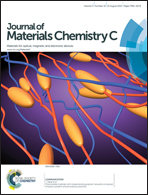The effect of azobenzene derivatives on UV-responsive organic thin-film transistors with a 2,7-dipentylbenzo[b]benzo[4,5]thieno[2,3-d]thiophene semiconductor†
Abstract
We have studied a UV responsive phototransistor and how the addition of various azobenzene derivatives alters the rise and relaxation times when exposed to and removed from UV light, respectively. A three-component semiconductor system was studied consisting of a UV responsive material C5-BTBT, a polymer binder PMMA, and 1 of 5 different azobenzene materials for UV response enhancement. The highest occupied molecular orbital (HOMO) and the lowest unoccupied molecular orbital (LUMO) were determined experimentally and found from DFT theory. Azobenzene units with a pendent nitro group have lower HOMO and LUMO levels than the semiconductor C5-BTBT. This combined with their electron withdrawing nature allows them to stabilize excited electrons, extending the lifetime of excitons, and keeping the system at a high current longer. Using a bi-exponential model, we see the relaxation rate constant τ increase from 278 to 578 s when nitro-azobenzene is used. Meanwhile, when azobenzene contains the electron donating unit −NH2, the HOMO of the material is found to be higher than that of C5-BTBT. This allowed another pathway for excited electrons to decay to their ground state, causing hole pair recombination, reducing IDS. The relaxation curves when UV light is removed demonstrate a clear increase in decay rate over the control system, showing that the charge donating amino-azobenzene assists in charge recombination.
![Graphical abstract: The effect of azobenzene derivatives on UV-responsive organic thin-film transistors with a 2,7-dipentylbenzo[b]benzo[4,5]thieno[2,3-d]thiophene semiconductor](/en/Image/Get?imageInfo.ImageType=GA&imageInfo.ImageIdentifier.ManuscriptID=C5TC01251A&imageInfo.ImageIdentifier.Year=2015)

 Please wait while we load your content...
Please wait while we load your content...